Staying afloat
Destination/ Adventure/ Kappayam
Sailing through the rough waters of Idamalayar.... unfolding the untold stories of reed cutters.... risk, adventure, rain and more.... a night with them in a reed hut....
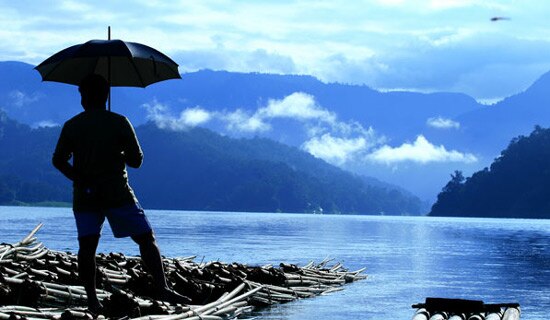
On a dark rainy October dawn, when anyone in this universe would prefer to snooze down, we set sail.....not in a smooth sea, rather through the rough waters of River Idamalayar. We steered in a country boat to Kappayam with a folk who have taken reed cutting as their livelihood. Their expedition is hard and risky. Isolation and despair haunt them throughout the journey; but they ain't gonna give up as their struggle is for a loaf of bread.
Climate is really unpredictable and no one really expected even a drizzle in the month of October. Shattering all the calculations the down pour became too heavy. Despite the heavy rain, they took board lamenting on the hardships and sufferings that life has stormed on them. Their expedition of reed cutting has a life span of fifteen days, during which each one is a lonely atoll caught between thick forest and wild waters. Loneliness is their only companion and the hues of the outside world exist only in their imagination. By the time the ferry to take them back home comes no one can predict who all'll be left there!
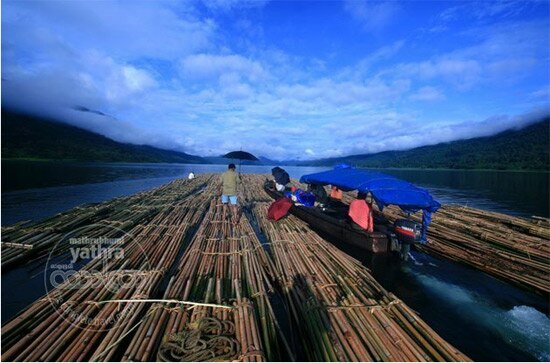
At last when the rain paused for a while the boat started to move on slowly. The boat seemed to have more sacks than people. Apart from rice, vegetables and utensils the sacks were filled with weapons and tarpaulin sheets intended to mount tents. There were men and women among them. Women have accompanied their husbands leaving their little ones home. Some others who have come alone parked themselves as lonely islands of solitude.
All through the journey, two things kept on troubling us- rain and kerosene. It was raining cats and dogs which kept us doused throughout the ride. The boat was functioning on a kerosene fuelled Yamaha engine and the shortage of kerosene badly affected our smooth ride. A burst of uproar came out from the Yamaha engine and the sleepy waters of Idamalayar woke up abruptly. This monstrous sound wave even made the river banks shiver. It kept out the elephant herds and they never came out from the darkness of the woods. Or was it rain that kept them away? The elephants usually come out of the forests to ease their thirst. Had it been summer, there would have been lots of them at the banks!
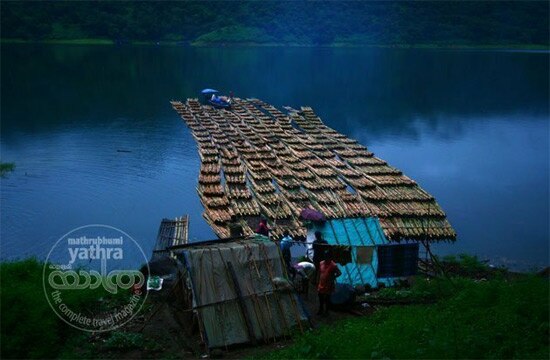
A thick silver line of fog outlined the dark green forest. Our boat reached near Anakkayamkuthu waterfalls were the waters crashed in to the river. Flocks of Eranda (a type of migratory water bird), were frolicking in from the white foamy ripples which spread all over the river. There was complete silence in the sixteen packed boat except for the roar of the Yamaha engine. In all the eyes staring at infinity, the story of the toil and struggles to make ends meet was writ large. The only mouth which spoke was that of Pankajakshi, better half of Velayudhan. She sat on the edge of the boat and kept on mumbling least bothered about the listeners around.
Our way took a gigantic turn and the background view of the huge wall of the Idamalayar dam faded out from our vision. This place is Eprah. On top of Eprah is Vachumaram, a place on the Athirappalli- Malakkappara State Highway. Eprah evoked in our eyes hopes to see elephants. And our eyes went busy surfing for huge dark creatures darting behind the woods. Above the forests on a farthest point a dwelling caught our sight. 'That is Idamalayar Watch Tower' screamed out Sudheesh, young Forestor of Idamalayar Range. He was accompanied by Siju who hails from Kozhikode. Department of Forests allows no one other than reed cutters to take this route. Passing by Koorkuzhi we reached Vadarmuzhi Allu. 'Allu' sounded interesting; it is a cave which can accommodate not less than ten. Tonight, we are to halt here. My mind made an attempt to imagine this strange cavern, but in vain.

When we reached Venmuzhi the couples among us started to descend. On the banks were small rafts made of reeds. These rafts have been made by them a couple of weeks ago, on their last visit to the atoll. Such rafts made ahead of the visit were found waiting on each atoll. These rafts have to be taken along while on their return journey to Idamalayar.
Venmuzhi atoll holds two to three huts made of reed, all made during the last visit. 'Oh my god it's all flooded, elephants have ruined them.' Mary read from the signs and screamed out. The river has over- flown and flooded the huts. Two of them have been destroyed by elephants too. They have to be mounted again. Some of them got down with sacks in their hands.
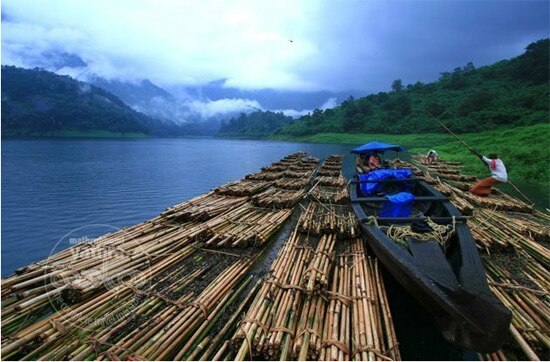
Yamaha started to groan again. Charupara arrived and Joseph the oldest in the crew got down. Thus each one was dropped at their atolls, just like people being deported. Ammayipara awaited us along with I.A.P.or I.A.Paulose, Watcher of Forest Department. Before even reaching the banks, Paulose registered his protest for not being there to take him a week before. His shabby attire and dry hair spoke the reason for such a response. This place holds one of Asia's biggest Teak trees and Pillai who guards it went ill. Paulose went to attend Pillai and thus happened to be in this lonely atoll. This stiff man accompanied us in the rest of the journey.
Thalippara surprised us with a fruit similar to papaya. Papaya in a forest? Our faces turned with a question mark. But the answer came in the form of a hut adjacent to it. A man in a traditional loin cloth along with a black lean dog stood there. Mathai, asked loudly at him 'Ossan, got any fish?' Mathai who led us is the brother of Elias, who holds the contract of porting the reed from Idamalayar to Bamboo Corporation Company. 'No', Ossan replied in a word. Ossan was one among those who thronged to Idamalayar during the construction of the Dam. But even after the construction works finished, he choose to stay there making reed cutting his profession. Passing by the last reed stations, Naivara and Kaliman, we reached Kappayam. It started to drizzle again. Water oozing out from high above the hill; caressing the rocks on its way and falling down to form the River Idamalyar was a ravishing scene. Near the source point on the rock is a dwelling. We were told that it was the hut of Soman Mooppan, (Mooppan is the name given to the Head of a tribal clan) of Mannan Clan of Arakkappu Tribal Colony. It is a place of comfort between the small intervals during fishing and reed cutting.
I have never seen a Mooppan before and this strained my patience to reach there as soon as possible. The way to the hut was rocky and we had to leave the boat for a Pondi(a small raft made of bamboo sticks) to reach there. Ramakrishnan of Mannan Clan standing on the other side helped us get on to the pondi. The ride on a pondi is interesting, though it is made of bamboo frame; you will literally be sitting in water, with your ass all dipped in water. The pondi reached the banks. Soman Mooppan in a red T and loin cloth welcomed us. We spent some time with him enjoying his talks. Radio is the only medium of entertainment here. The rhythm of the rain outside and the noise of radio surfing for stations sounded similar. The forest at the end of Idamalayar leads way to Arakkappu Colony. Climbing up the hill is Malakkappara, a small hilly village destined to tailor Tamil Nadu and Kerala. Suddenly the rain became heavy. We took seats in Pondi along with Ramakrishnan. The Pondi swayed as immature feet landed on it. Idamalayar has a depth around 650 ft; which simply means a small misstep can be a great mishap. Pondi reached safe at our boat. Ramakrishnan offered Mathai a bunch of fresh fish hooked to a string.
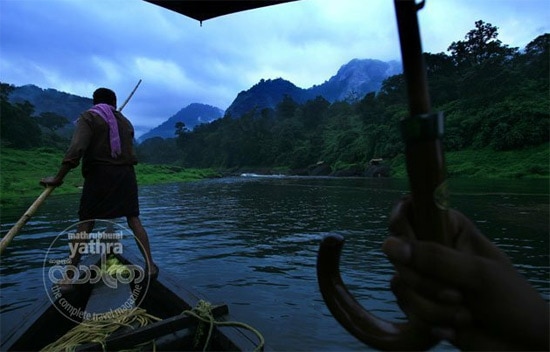
Next on the do list was reed gathering. The reed rafts gathered by the tribes at Kaliman would be tied to our boat. They were paid Rs.70 for a bunch, which contains 20 reeds. On the whole they looked like a green carpet spread over the waters. Sasi, who has been leading the reed gathering team for years, laid his hands on the Yamaha engine and our boat became surrounded by floating reeds. The reed clusters on both sides of our boat was then tied to it. It took two hours to cover the 24 kms journey from Idamalayar to Kappayam. But this calculation cannot be applied to the return journey. The collection of reeds will delay the trip. And if there are more reeds to be gathered the journey will prolong. It's highly unpredictable- it may take five hours, sometimes two days or even more. Regardless of the heavy rain, the raft started to move taking along the reeds with it. Reed carpets were waiting on every atoll. They were gathered and tied to the 'mother' raft. Like a mother hen gathers its chicks behind its wings the mother raft sailed gathering the reeds from atoll to atoll. To certain atolls where the 'mother' raft cannot sail, Mathai himself swam and gathered and got the reeds tied. The raft became fatter and fatter with reeds all around it.

By the time the reeds were gathered at Charupara the sky turned dark. Next destination is Venmuzhi, there we have to get down. By then Venmuzhi got decorated with cute thatched huts, all made of reeds. The smoke from the huts got spread in the atmosphere. Inside of the house was equipped with panels made of reed for keeping utensils and a bed spread like sheet made by beating reed. Even the clothes line was made from reed. We were fishing in the waterfalls at the backward of the hut to kill time when Mary called us for food. Boiled rice was served hot from big clay pot using a spoon made of reed and coconut shell. The savor of spicy fish curry whetted our appetite had a bellyful. 'Going to Varmuzhiallu is not safe, Allu gets flooded when it rains heavy, we shall halt here tonight' advised Sasi.
Darkness all around. Kerosene lanterns lighted the huts. 'Those days were really terrible when we had no dam here, it was water all around.' Peter started to unfold his stories' The river stretched to 34 kms. The flow was so rapid that it took only one and half hours from Kappayam to Ennakkayam in a reed raft. In between there were cliffs and to take the raft safe to the destination without hitting the cliffs was really challenging. You light a beedi(Indian cigarette) from kappayam and it will be there at your lips till you reach Ennakkallu, little will you notice that the spark has blown out while you were busy sailing!'

Reed cutting as in other parts of the world is not a lucrative business here. Accidents accompany them as shadows. Many have come across elephants when they go deep the forest for cutting reed. Some others have sat with the corpse of their fellow friend for more than two days. When wild elephants trumpet around their huts, what else these poor souls can do other than sit with the kerosene lantern and shiver for life! Mary lost her brother during such a reed cutting expedition. There were steep cliffs after Ennakkayam, the flow was so strong that he lost control of the raft, which fell on to the cliffs and took his life. Narrating the incident Mary's eyes went wet. Almost all in the crew are above their middle ages. 'Younger generation finds this profession unappealing. Considering the risk and physical strain they say such a job will be paid four times more at their place.' Said Varkhey with a sigh. These words brought in me the realization that I am sitting with a set that are largely on the verge of extinction.

Nights are a nightmare. They sleep with the lighted kerosene lamps in their huts. It will burn till day break. They are believed to keep the wild animals away. But their beliefs are at times turned upside down when they hear about incidents of elephant attacks. During such situations they are largely helpless; they could only take a pondi and run (rather sail) for life leaving everything behind. Trusting the kerosene lantern, we spent that night with them, being one among them, pondering on the promises of life and ecstasies of love and little bothered about what is in store for us.
Mathai woke us from sleep. When I became aware of the surroundings I just touched my head to make sure it is in place, thank all, elephants have not landed on us. Had tea and got on to the boat just before day break. Like a floating atoll, the raft sailed away from Venmuzhi. Biding adieu they stood near the hut looking at us till the raft went out of sight. We too gazed at them.
They will now move to the forest for cutting reeds, will go 3 to 4 kms in-to the forests, there they cut reed, carry on their shoulders and gather them along the banks.
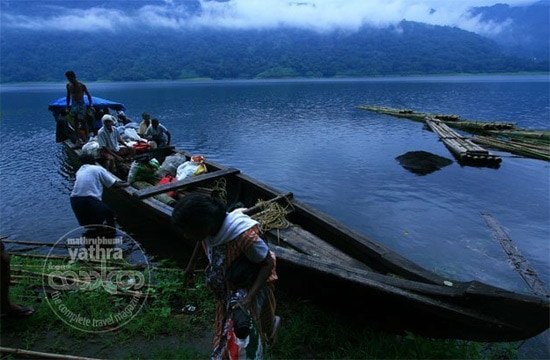
It has stopped raining and the forest appeared with a canopy of white fog. The waterfalls seemed to us as white thread laid on a green piece of cloth. I.A.P in his ragged shirt and sleeves folded up started to smoke first sitting and then standing on the front panel of the raft. The smoke of the beedi merges with the fog, or is he taking in the fog too? my doubts knew no bounds. Aikkara Watch Tower was clearly visible as a house above the forest with no contact with the rest of the surroundings. By then the sun became hot and we felt burning under it. The same mouth that cursed the rain cursed the sun also. All took relief under umbrellas, and some fit themselves in the small hollow of the boat. The rain has made the forest even more beautiful. The image of the green atolls shined in the silent waters as if they were admiring their beauty at a mirror. The sound of trees being destroyed came piercing the Yamaha roar. Elephant herd is somewhere around. Since it will take time for them to reach the banks we moved on.
Anakkayayamkuthu found more visible and our country boat turned towards the Idamalayar dam. At last we reached Ennakkallu. Got down and climbed up. Thousand bunches of reeds have been ported. Just turned back and had a look. Swaying and tilting as a half wet strip of paper, reeds remained as a spacious playground. Suddenly some questions popped up in my mind. Will the reed cutters be still in the forest? Will they be safe from the elephant herds?
 Text : T J Sreejith
Text : T J Sreejith
Photos: P Jayesh
Translation: Soumya Bhushan
Sailing through the rough waters of Idamalayar.... unfolding the untold stories of reed cutters.... risk, adventure, rain and more.... a night with them in a reed hut....

On a dark rainy October dawn, when anyone in this universe would prefer to snooze down, we set sail.....not in a smooth sea, rather through the rough waters of River Idamalayar. We steered in a country boat to Kappayam with a folk who have taken reed cutting as their livelihood. Their expedition is hard and risky. Isolation and despair haunt them throughout the journey; but they ain't gonna give up as their struggle is for a loaf of bread.
Climate is really unpredictable and no one really expected even a drizzle in the month of October. Shattering all the calculations the down pour became too heavy. Despite the heavy rain, they took board lamenting on the hardships and sufferings that life has stormed on them. Their expedition of reed cutting has a life span of fifteen days, during which each one is a lonely atoll caught between thick forest and wild waters. Loneliness is their only companion and the hues of the outside world exist only in their imagination. By the time the ferry to take them back home comes no one can predict who all'll be left there!

At last when the rain paused for a while the boat started to move on slowly. The boat seemed to have more sacks than people. Apart from rice, vegetables and utensils the sacks were filled with weapons and tarpaulin sheets intended to mount tents. There were men and women among them. Women have accompanied their husbands leaving their little ones home. Some others who have come alone parked themselves as lonely islands of solitude.
All through the journey, two things kept on troubling us- rain and kerosene. It was raining cats and dogs which kept us doused throughout the ride. The boat was functioning on a kerosene fuelled Yamaha engine and the shortage of kerosene badly affected our smooth ride. A burst of uproar came out from the Yamaha engine and the sleepy waters of Idamalayar woke up abruptly. This monstrous sound wave even made the river banks shiver. It kept out the elephant herds and they never came out from the darkness of the woods. Or was it rain that kept them away? The elephants usually come out of the forests to ease their thirst. Had it been summer, there would have been lots of them at the banks!

A thick silver line of fog outlined the dark green forest. Our boat reached near Anakkayamkuthu waterfalls were the waters crashed in to the river. Flocks of Eranda (a type of migratory water bird), were frolicking in from the white foamy ripples which spread all over the river. There was complete silence in the sixteen packed boat except for the roar of the Yamaha engine. In all the eyes staring at infinity, the story of the toil and struggles to make ends meet was writ large. The only mouth which spoke was that of Pankajakshi, better half of Velayudhan. She sat on the edge of the boat and kept on mumbling least bothered about the listeners around.
Our way took a gigantic turn and the background view of the huge wall of the Idamalayar dam faded out from our vision. This place is Eprah. On top of Eprah is Vachumaram, a place on the Athirappalli- Malakkappara State Highway. Eprah evoked in our eyes hopes to see elephants. And our eyes went busy surfing for huge dark creatures darting behind the woods. Above the forests on a farthest point a dwelling caught our sight. 'That is Idamalayar Watch Tower' screamed out Sudheesh, young Forestor of Idamalayar Range. He was accompanied by Siju who hails from Kozhikode. Department of Forests allows no one other than reed cutters to take this route. Passing by Koorkuzhi we reached Vadarmuzhi Allu. 'Allu' sounded interesting; it is a cave which can accommodate not less than ten. Tonight, we are to halt here. My mind made an attempt to imagine this strange cavern, but in vain.

When we reached Venmuzhi the couples among us started to descend. On the banks were small rafts made of reeds. These rafts have been made by them a couple of weeks ago, on their last visit to the atoll. Such rafts made ahead of the visit were found waiting on each atoll. These rafts have to be taken along while on their return journey to Idamalayar.
Venmuzhi atoll holds two to three huts made of reed, all made during the last visit. 'Oh my god it's all flooded, elephants have ruined them.' Mary read from the signs and screamed out. The river has over- flown and flooded the huts. Two of them have been destroyed by elephants too. They have to be mounted again. Some of them got down with sacks in their hands.

Yamaha started to groan again. Charupara arrived and Joseph the oldest in the crew got down. Thus each one was dropped at their atolls, just like people being deported. Ammayipara awaited us along with I.A.P.or I.A.Paulose, Watcher of Forest Department. Before even reaching the banks, Paulose registered his protest for not being there to take him a week before. His shabby attire and dry hair spoke the reason for such a response. This place holds one of Asia's biggest Teak trees and Pillai who guards it went ill. Paulose went to attend Pillai and thus happened to be in this lonely atoll. This stiff man accompanied us in the rest of the journey.
Thalippara surprised us with a fruit similar to papaya. Papaya in a forest? Our faces turned with a question mark. But the answer came in the form of a hut adjacent to it. A man in a traditional loin cloth along with a black lean dog stood there. Mathai, asked loudly at him 'Ossan, got any fish?' Mathai who led us is the brother of Elias, who holds the contract of porting the reed from Idamalayar to Bamboo Corporation Company. 'No', Ossan replied in a word. Ossan was one among those who thronged to Idamalayar during the construction of the Dam. But even after the construction works finished, he choose to stay there making reed cutting his profession. Passing by the last reed stations, Naivara and Kaliman, we reached Kappayam. It started to drizzle again. Water oozing out from high above the hill; caressing the rocks on its way and falling down to form the River Idamalyar was a ravishing scene. Near the source point on the rock is a dwelling. We were told that it was the hut of Soman Mooppan, (Mooppan is the name given to the Head of a tribal clan) of Mannan Clan of Arakkappu Tribal Colony. It is a place of comfort between the small intervals during fishing and reed cutting.
I have never seen a Mooppan before and this strained my patience to reach there as soon as possible. The way to the hut was rocky and we had to leave the boat for a Pondi(a small raft made of bamboo sticks) to reach there. Ramakrishnan of Mannan Clan standing on the other side helped us get on to the pondi. The ride on a pondi is interesting, though it is made of bamboo frame; you will literally be sitting in water, with your ass all dipped in water. The pondi reached the banks. Soman Mooppan in a red T and loin cloth welcomed us. We spent some time with him enjoying his talks. Radio is the only medium of entertainment here. The rhythm of the rain outside and the noise of radio surfing for stations sounded similar. The forest at the end of Idamalayar leads way to Arakkappu Colony. Climbing up the hill is Malakkappara, a small hilly village destined to tailor Tamil Nadu and Kerala. Suddenly the rain became heavy. We took seats in Pondi along with Ramakrishnan. The Pondi swayed as immature feet landed on it. Idamalayar has a depth around 650 ft; which simply means a small misstep can be a great mishap. Pondi reached safe at our boat. Ramakrishnan offered Mathai a bunch of fresh fish hooked to a string.

Next on the do list was reed gathering. The reed rafts gathered by the tribes at Kaliman would be tied to our boat. They were paid Rs.70 for a bunch, which contains 20 reeds. On the whole they looked like a green carpet spread over the waters. Sasi, who has been leading the reed gathering team for years, laid his hands on the Yamaha engine and our boat became surrounded by floating reeds. The reed clusters on both sides of our boat was then tied to it. It took two hours to cover the 24 kms journey from Idamalayar to Kappayam. But this calculation cannot be applied to the return journey. The collection of reeds will delay the trip. And if there are more reeds to be gathered the journey will prolong. It's highly unpredictable- it may take five hours, sometimes two days or even more. Regardless of the heavy rain, the raft started to move taking along the reeds with it. Reed carpets were waiting on every atoll. They were gathered and tied to the 'mother' raft. Like a mother hen gathers its chicks behind its wings the mother raft sailed gathering the reeds from atoll to atoll. To certain atolls where the 'mother' raft cannot sail, Mathai himself swam and gathered and got the reeds tied. The raft became fatter and fatter with reeds all around it.

By the time the reeds were gathered at Charupara the sky turned dark. Next destination is Venmuzhi, there we have to get down. By then Venmuzhi got decorated with cute thatched huts, all made of reeds. The smoke from the huts got spread in the atmosphere. Inside of the house was equipped with panels made of reed for keeping utensils and a bed spread like sheet made by beating reed. Even the clothes line was made from reed. We were fishing in the waterfalls at the backward of the hut to kill time when Mary called us for food. Boiled rice was served hot from big clay pot using a spoon made of reed and coconut shell. The savor of spicy fish curry whetted our appetite had a bellyful. 'Going to Varmuzhiallu is not safe, Allu gets flooded when it rains heavy, we shall halt here tonight' advised Sasi.
Darkness all around. Kerosene lanterns lighted the huts. 'Those days were really terrible when we had no dam here, it was water all around.' Peter started to unfold his stories' The river stretched to 34 kms. The flow was so rapid that it took only one and half hours from Kappayam to Ennakkayam in a reed raft. In between there were cliffs and to take the raft safe to the destination without hitting the cliffs was really challenging. You light a beedi(Indian cigarette) from kappayam and it will be there at your lips till you reach Ennakkallu, little will you notice that the spark has blown out while you were busy sailing!'

Reed cutting as in other parts of the world is not a lucrative business here. Accidents accompany them as shadows. Many have come across elephants when they go deep the forest for cutting reed. Some others have sat with the corpse of their fellow friend for more than two days. When wild elephants trumpet around their huts, what else these poor souls can do other than sit with the kerosene lantern and shiver for life! Mary lost her brother during such a reed cutting expedition. There were steep cliffs after Ennakkayam, the flow was so strong that he lost control of the raft, which fell on to the cliffs and took his life. Narrating the incident Mary's eyes went wet. Almost all in the crew are above their middle ages. 'Younger generation finds this profession unappealing. Considering the risk and physical strain they say such a job will be paid four times more at their place.' Said Varkhey with a sigh. These words brought in me the realization that I am sitting with a set that are largely on the verge of extinction.

Nights are a nightmare. They sleep with the lighted kerosene lamps in their huts. It will burn till day break. They are believed to keep the wild animals away. But their beliefs are at times turned upside down when they hear about incidents of elephant attacks. During such situations they are largely helpless; they could only take a pondi and run (rather sail) for life leaving everything behind. Trusting the kerosene lantern, we spent that night with them, being one among them, pondering on the promises of life and ecstasies of love and little bothered about what is in store for us.
Mathai woke us from sleep. When I became aware of the surroundings I just touched my head to make sure it is in place, thank all, elephants have not landed on us. Had tea and got on to the boat just before day break. Like a floating atoll, the raft sailed away from Venmuzhi. Biding adieu they stood near the hut looking at us till the raft went out of sight. We too gazed at them.
They will now move to the forest for cutting reeds, will go 3 to 4 kms in-to the forests, there they cut reed, carry on their shoulders and gather them along the banks.

It has stopped raining and the forest appeared with a canopy of white fog. The waterfalls seemed to us as white thread laid on a green piece of cloth. I.A.P in his ragged shirt and sleeves folded up started to smoke first sitting and then standing on the front panel of the raft. The smoke of the beedi merges with the fog, or is he taking in the fog too? my doubts knew no bounds. Aikkara Watch Tower was clearly visible as a house above the forest with no contact with the rest of the surroundings. By then the sun became hot and we felt burning under it. The same mouth that cursed the rain cursed the sun also. All took relief under umbrellas, and some fit themselves in the small hollow of the boat. The rain has made the forest even more beautiful. The image of the green atolls shined in the silent waters as if they were admiring their beauty at a mirror. The sound of trees being destroyed came piercing the Yamaha roar. Elephant herd is somewhere around. Since it will take time for them to reach the banks we moved on.
Anakkayayamkuthu found more visible and our country boat turned towards the Idamalayar dam. At last we reached Ennakkallu. Got down and climbed up. Thousand bunches of reeds have been ported. Just turned back and had a look. Swaying and tilting as a half wet strip of paper, reeds remained as a spacious playground. Suddenly some questions popped up in my mind. Will the reed cutters be still in the forest? Will they be safe from the elephant herds?
 Text : T J Sreejith
Text : T J SreejithPhotos: P Jayesh
Translation: Soumya Bhushan